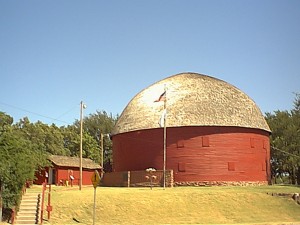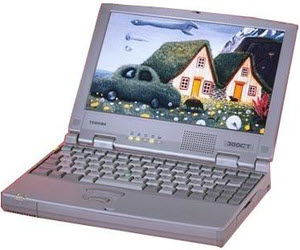 Having blown nearly 400 bucks on a camera, I returned to the used market for a laptop and picked up a Toshiba Portege 300CT for $251 in June of 2001. A 1.5 GB hard disk was standard for this model but this unit had been upgraded to 4.1 GB. It also contained the maximum 64 MB of memory. The processor was a 133 MHz Intel Pentium. It was running Linux when I got it but I installed Windows 98 almost immediately.
Having blown nearly 400 bucks on a camera, I returned to the used market for a laptop and picked up a Toshiba Portege 300CT for $251 in June of 2001. A 1.5 GB hard disk was standard for this model but this unit had been upgraded to 4.1 GB. It also contained the maximum 64 MB of memory. The processor was a 133 MHz Intel Pentium. It was running Linux when I got it but I installed Windows 98 almost immediately.
The 12 VDC power supply I had purchased for the Libretto worked just fine with the Portege. I had plotted my version of my great-grandparents’ trip using Microsoft Streets & Trips and planned to actually use the Portege in the car to follow the plotted route. In theory, the Garmin III Plus GPS I owned could be used to drive Streets & Trips (CORRECTION: My recollection was wrong. While Streets & Trips was used in some of the planning, it was almost certainly DeLorme’s Street Atlas that was used with the GPS in the car.) and I had the cables to make all the power and data connections but the result was a tangle of wire that was truly scary in the small cockpit of the Corvette. So, for $167, I bought a Hyperdata GPS unit specifically to connect to the computer. This was a brand new model that was powered through its USB connection thus simplifying cabling just a bit.
The 2001 Florida trip is the only one that really made use of this setup. My girl friend, Chris, navigated the entire trip with the Portege on her lap with a pillow for insulation from the heat of the computer. Chris never complained and even stayed with me for another four years before moving on so the trip didn’t really end our relationship. I’ve a strong suspicion, however, that stunts like that are part of the reason I no longer have a girl friend.

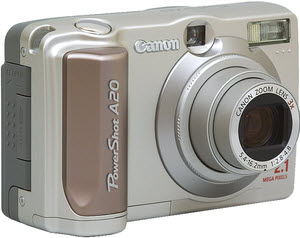 As I looked back over my travel gadget purchases, it was immediately obvious that many preceded a major trip. The idea of a long lived website, rather than a one trip experiment, started to form as I got serious about retracing a 1920 Florida trip
As I looked back over my travel gadget purchases, it was immediately obvious that many preceded a major trip. The idea of a long lived website, rather than a one trip experiment, started to form as I got serious about retracing a 1920 Florida trip 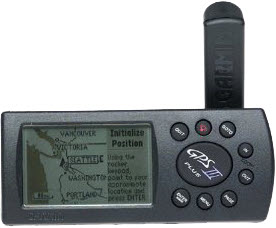 The Garmin GPS III Plus was pretty high-end for a personal GPS in 1999. In July of that year, this baby set me back a whopping $355. Some rather detailed maps could be downloaded to it and it could tell you where things were relative to where you were but it couldn’t tell you how to get there. I’m fairly certain that there was a GPS IV that offered routing but I can find nothing online about it. Today’s web claims that the earliest GPS of this style that did routing was the GPS V. The GPS V was described as a “versatile navigator”. The III Plus merely had “cartographic capabilities”. I always thought of it as an automatically scrolling map.
The Garmin GPS III Plus was pretty high-end for a personal GPS in 1999. In July of that year, this baby set me back a whopping $355. Some rather detailed maps could be downloaded to it and it could tell you where things were relative to where you were but it couldn’t tell you how to get there. I’m fairly certain that there was a GPS IV that offered routing but I can find nothing online about it. Today’s web claims that the earliest GPS of this style that did routing was the GPS V. The GPS V was described as a “versatile navigator”. The III Plus merely had “cartographic capabilities”. I always thought of it as an automatically scrolling map.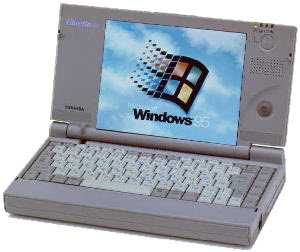 My first portable computer was a Toshiba Libretto 50CT. This was a truly small machine for its day with a weight of 1.87 pounds (with battery) and dimensions of 8.27″L x 4.53″W x 1.34”H. It had a 6.1″ screen, a 770 MB hard disk, 16 MB of RAM, and a 75 MHz Intel Pentium processor running Windows 95. Perhaps its most unusual feature was the built in pointing device. It’s a button to the right of the screen that you move with your thumb while your fingers fall on two buttons on the back of the screen for “clicking”. It may sound awkward but was very natural and I liked it. Toshiba called this AccuPoint and claimed it as a trade mark. A search for it today shows it as the registered name of brand of hunting scopes.
My first portable computer was a Toshiba Libretto 50CT. This was a truly small machine for its day with a weight of 1.87 pounds (with battery) and dimensions of 8.27″L x 4.53″W x 1.34”H. It had a 6.1″ screen, a 770 MB hard disk, 16 MB of RAM, and a 75 MHz Intel Pentium processor running Windows 95. Perhaps its most unusual feature was the built in pointing device. It’s a button to the right of the screen that you move with your thumb while your fingers fall on two buttons on the back of the screen for “clicking”. It may sound awkward but was very natural and I liked it. Toshiba called this AccuPoint and claimed it as a trade mark. A search for it today shows it as the registered name of brand of hunting scopes.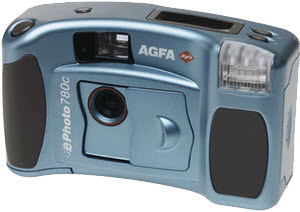 There has always been some hardware associated with my road trips. In order to update a website, I needed some sort of computer and, if I intended to include photos in those updates, I needed a digital camera. GPS has also been part of the mix from the beginning. A computer, a camera, and a GPS receiver have been my travel companions on every trip but they have changed at least as much as I have though in different directions. While I’ve gotten weaker and slower and balder, they’ve become more powerful, faster, and more loaded with features.
There has always been some hardware associated with my road trips. In order to update a website, I needed some sort of computer and, if I intended to include photos in those updates, I needed a digital camera. GPS has also been part of the mix from the beginning. A computer, a camera, and a GPS receiver have been my travel companions on every trip but they have changed at least as much as I have though in different directions. While I’ve gotten weaker and slower and balder, they’ve become more powerful, faster, and more loaded with features.